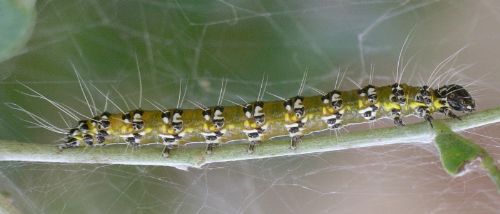by Valerie
March, 2009Genista Caterpillar
Small caterpillars rarely have common names. That is, unless they are destructive enough to come to the attention of gardeners, homeowners, or anyone who has trees that they wish to keep attractive. The genista caterpillar (Uresiphita reversalis) is one of those notorious little pests that exists in great numbers here in central Texas. It is a native moth, present all year long, with overlapping generations that tend to take advantage of the weather and new plant growth. Genista caterpillars feed on legumes, and their favorite plant is Texas mountain laurel (Sophora secundiflora). When the trees bloom in the spring, the caterpillars are there, ready to munch on the buds and blossoms. When we have rains during the summer and the trees produce some new growth, the caterpillars are there again. They like the tender young shoots, but seem to find the older leaves inedible. If there are not too many caterpillars, then their feeding does little to affect the tree, but if there are a lot, the blossoms or new leaves will be damaged and unsightly. These larvae make a loose sort of webbing around their feeding areas, with several individuals usually staying close together within the strands of silk. They can be confused with fall webworms, but it is simply a similar defense strategy: the web makes it harder for predators and parasites to get to the caterpillars. Genista caterpillars do not only feed on Texas mountain laurel; their second favorite meal is bluebonnets. Because there are multiple generations of moths during the year, they sometimes do not coincide with optimum Texas mountain laurel growth, so they have a backup plan. I've seen them eating bluebonnet seedlings in December, as well as the flowers later in the spring. The adult moths are rather nondescript. They are triangular in shape, with reddish brown on top and white underneath. The adults are noticed far less often than the larvae. |